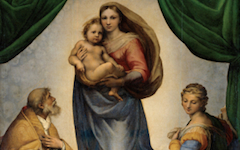Raphael’s Expulsion of Heliodorus (1511-12)
Once again, here are just a few observations on a real masterpiece, one un-noted before, the other probably. The apparent narrative of Raphael's Expulsion of Heliodorus is an episode in Maccabees 2, a book in the Catholic Old Testament not included in either the Hebrew Old Testament or, after Raphael, in the Protestant one.

Raphael, Expulsion of Heliodorus (1511-12) Fresco. Apostolic Palace, Vatican.
Click image to enlarge.
Heliodorus, on orders from the Syrian king, seizes the treasure in the Temple. God then sends a horseman assisted by two spiritual beings to drive Heliodorus out. He lies on the ground in the lower right-hand corner under attack from his three assailants. The action thus principally takes place on the right-hand side.
Click next thumbnail to continue
On the left-hand side is the picture's patron, Pope Julius II, being carried in on a litter to watch the events. At far left is Raphael himself in an accepted self-portrait with two bearded carriers to his right, their heads roughly on the same level. Yet I doubt anyone but artists has ever noted that all three essentially have the same face.
Click next thumbnail to continue

Detail of Raphael's Expulsion of Heliodorus (above) with 3 further details (below).
Click image to enlarge.
The papal bearers are bearded but all part their hair in the center with the same eyebrows, noses and lips. They are variations on Raphael's own face from three different angles (see bottom row). One characteristic of a mental image is that you see objects, especially faces, from multiple angles simultaneously. That's what Picasso was doing in Cubism (see Cubism Explained), something he no doubt gathered from earlier art and probably saw at work, in this compelling illusion, here.1 What seems outside Raphael's head as a narrative image is, in fact, inside it as a mental one.
Click next thumbnail to continue
That's why the angels whip Heliodorus. As winged alter egos of Raphael's imagination in flight, they paint Heliodorus. Their whips are visual metaphors for the artist's brush. Violence is commonly used in art to convey the mental anguish involved during the struggle to create. Now note how the shadow of the nearest angel falls like a dark oval in the center of the central octagonal stone. The stone is an "eyeball" with the shadow its "pupil" and the altar directly above. With the angel seeming to float above the surface of the picture, how can he not be "Raphael" in the mirror of his mind?
Click next thumbnail to continue
Flip the angel (left) and he forms an R for Raphael (right). Raphael often signed his pictures within the image, as on an armband of La Fornarina. Rona Goffen wrote about those.2 What is not known is how commonly he used the method to indicate his self.3
So, the Pope emerges from three "Raphaels" on the left while watching himself in action on the right. The R-shaped angel floats above the painting, its shadow "a divine eye". The assailants too, sent by God, are Raphael while the picture they "paint", Heliodorus, must be as well.
__________________________________
Note: For how this painting inspired a later artist, see Renoir's Dance in the Country (1883)
More Works by Raphael
New revelations, as always, about one of the world's most famous portraits

Raphael’s La Donna Velata (c.1516)
Notes:
1. See also "Mental Images from Holbein, Ingres and Picasso." Besides those three artists I have also shown how others use multiple or fragmentary views to depict a mental image. They include by Dürer (1491), Delacroix (1837), Degas (1867 and 1869), Bonnard (1897), Giorgio Morandi (1926), Claus Oldenburg (1959), Francis Bacon (1962), Lucian Freud (2002), Anish Kapoor (2008) and James Nares (2013).
2. Rona Goffen, “Raphael’s Designer Labels: From the Virgin Mary to La Fornarina”, Artibus et Historiae 24, No. 48, 2003, pp. 123-42
3. See how Raphael at only 19 years of age formed both of his initials (R and S) out of the same links in a gold chain in his St. Sebastian (c.1502-3).
Original Publication Date on EPPH: 13 Nov 2013. © Simon Abrahams. Articles on this site are the copyright of Simon Abrahams. To use copyrighted material in print or other media for purposes beyond 'fair use', you must obtain permission from the copyright owner. Websites may link to this page without permission (please do) but may not reproduce the material on their own site without crediting Simon Abrahams and EPPH.





